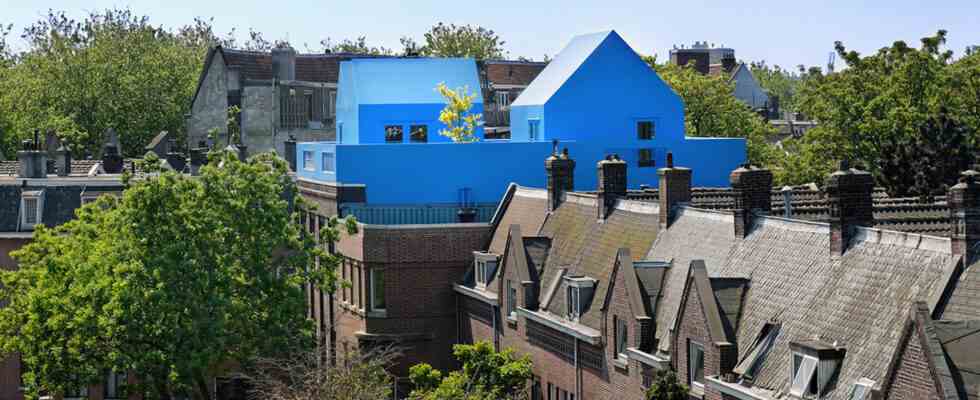Europe Magazine
As of: 07/09/2022 3:34 p.m
Rotterdam has more flat roofs than any other city in the Netherlands. This area should be used: for climate protection, for food, against lack of space and also for the eyes.
Summer begins and Rotterdam climbs onto the roof – away from the street noise and into the oasis of peace. At the so-called Rooftop Festival, the focus is on a change of perspective. Entrepreneur Léon van Geest wants to encourage people to use the city differently.
The organizer of the annual “Rotterdamse Dakendagen” – the roof days of Rotterdam – is committed to using roofs to green the city, save water and generate energy.
Above all, they should be there for the people. In big cities there is less and less living space, areas are becoming denser. The space on the roofs must therefore be used, says van Geest.
Crazy roof constructions for climate protection
Cornelia Kolden, WDR, Europamagazin, July 9, 2022
Lots of unused space
Especially in Rotterdam: street canyons, wide boulevards and post-war functional buildings characterize the city. It is precisely to this fact that Rotterdam owes the highest number of flat roofs in the Netherlands. Around 18 square kilometers of additional space at a dizzy height could be used – for art, nature and technology, or just for looking.
However, not all roofs are sustainable – because in the past people liked to save on the roof. An enthusiastic visitor to the rooftop festival agrees that this needs to change urgently: “Now you have a great view of the street and buildings from above, it gives you a wider perspective. I’m in love with Rotterdam.”
From flat roof to flat roof: At the Rooftop Festival, bridges lead visitors from house to house.
Image: EPA
A solution to the water problem
It’s about more than putting a few flower pots on the roof. The flagship project: the “DakAkker”. Since 2012, an office building has been crowned by the largest rooftop field in the Netherlands – at least 1000 square meters, including a café. The city of Rotterdam is experimenting with urban biodiversity here and is even planning to change one or the other building law.
Dachacker founder Emile van Rinsum from the Rotterdam Environment Center is enthusiastic: In addition to beautiful green areas on roofs, you can also create entire parks where you can go for a walk.
But the most important thing for him is the solution to the water problem: rain can be collected and released automatically via a water collection system. With this, van Rinsum can already water his plants, which he then sells to restaurants in the area. It’s hard to eat more locally.
Practical and with an eye-catching effect
Architecture all in Smurf blue that immediately catches the eye: the so-called Didden houses fascinate architecture fans from all over the world. The Didden family of artists, with their strong collector instinct and two children, simply had space problems in their loft and felt compelled to expand their traditional roof.
The family reaches their radiant blue terraced landscape with two small houses via hanging spiral staircases. The sons can also let themselves up and down using a rope. There are niches for the children, while Gies, the mother, wanted her own shower in her bedroom.
But the implementation was not easy. The roof had to be massively reinforced. It needed permits, but most importantly someone to build this “blue wonder”. Gies van der Kamp, owner of the Didden houses, complains: “We took the designs to many building contractors. They all said: ‘No, maybe you’ll come back when you’ve found a decent piece of land’.”
Screaming blue and architecturally sophisticated: the Didden Houses in Rotterdam
Rethinking roof construction
Then the family turned to stage designers. They could have implemented it, but would not have had the craftsmanship to build it stably enough. Next, the Diddens tried a company that builds amusement park attractions — roller coasters, for example. They too could have implemented the plans, but wanted to build with polyester. However, the potential years of stench deterred the Didden family from doing so.
In the end, architect Winy Maas, who is now also involved in designing the roof days, was found for the project. At that time he was already building great things all over the world and stands for high-flying plans. But it was the small houses that started his love for Rotterdam’s roofs: “Part of the rooftop days that we organized here is this atmosphere of really enjoying living in cities, and that also means that the roofs are used better “, he says.
Maas sees it positively that reinforced roofs should become a requirement for all houses that are built in Rotterdam in the future: “In this way we create the potential for the next generation to make everything greener, save more water, plant entire forests and of course more living space. “
One of the architect’s latest Rotterdam projects: a spectacular museum depot – of course crowned by a forest that grows into the Rotterdam sky.
You can see this and other reports in Europamagazin – on Sunday at 12.45 p.m. in the first.

